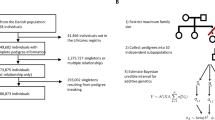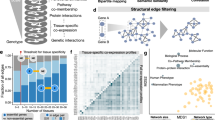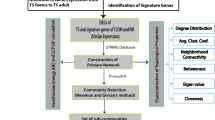Abstract
Gene coexpression relationships that are phylogenetically conserved between human and mouse have been shown to provide important clues about gene function that can be efficiently used to identify promising candidate genes for human hereditary disorders. In the past, such approaches have considered mostly generic gene expression profiles that cover multiple tissues and organs. The individual genes of multicellular organisms, however, can participate in different transcriptional programs, operating at scales as different as single-cell types, tissues, organs, body regions or the entire organism. Therefore, systematic analysis of tissue-specific coexpression could be, in principle, a very powerful strategy to dissect those functional relationships among genes that emerge only in particular tissues or organs. In this report, we show that, in fact, conserved coexpression as determined from tissue-specific and condition-specific data sets can predict many functional relationships that are not detected by analyzing heterogeneous microarray data sets. More importantly, we find that, when combined with disease networks, the simultaneous use of both generic (multi-tissue) and tissue-specific conserved coexpression allows a more efficient prediction of human disease genes than the use of generic conserved coexpression alone. Using this strategy, we were able to identify high-probability candidates for 238 orphan disease loci. We provide proof of concept that this combined use of generic and tissue-specific conserved coexpression can be very useful to prioritize the mutational candidates obtained from deep-sequencing projects, even in the case of genetic disorders as heterogeneous as XLMR.
Similar content being viewed by others
Log in or create a free account to read this content
Gain free access to this article, as well as selected content from this journal and more on nature.com
or
References
Yang JY, Yang MQ, Zhu MM, Arabnia HR, Deng Y : Promoting synergistic research and education in genomics and bioinformatics. BMC Genomics 2008; 9 (Suppl 1): I1.
Barabasi AL, Oltvai ZN : Network biology: understanding the cell’s functional organization. Nat Rev Genet 2004; 5: 101–113.
Oti M, Brunner HG : The modular nature of genetic diseases. Clin Genet 2007; 71: 1–11.
Wang X, Dalkic E, Wu M, Chan C : Gene module level analysis: identification to networks and dynamics. Curr Opin Biotechnol 2008; 19: 482–491.
Turner FS, Clutterbuck DR, Semple CA : POCUS: mining genomic sequence annotation to predict disease genes. Genome Biol 2003; 4: R75.
Franke L, van Bakel H, Fokkens L, de Jong ED, Egmont-Petersen M, Wijmenga C : Reconstruction of a functional human gene network, with an application for prioritizing positional candidate genes. Am J Hum Genet 2006; 78: 1011–1025.
Eisen MB, Spellman PT, Brown PO, Botstein D : Cluster analysis and display of genome-wide expression patterns. Proc Natl Acad Sci USA 1998; 95: 14863–14868.
Zhou XJ, Kao MC, Huang H et al: Functional annotation and network reconstruction through cross-platform integration of microarray data. Nat Biotechnol 2005; 23: 238–243.
Pellegrino M, Provero P, Silengo L, Di Cunto F : CLOE: identification of putative functional relationships among genes by comparison of expression profiles between two species. BMC Bioinformatics 2004; 5: 179.
Stuart JM, Segal E, Koller D, Kim SK : A gene-coexpression network for global discovery of conserved genetic modules. Science 2003; 302: 249–255.
Oti M, van Reeuwijk J, Huynen MA, Brunner HG : Conserved co-expression for candidate disease gene prioritization. BMC Bioinformatics 2008; 9: 208.
Ala U, Piro RM, Grassi E et al: Prediction of human disease genes by human–mouse conserved coexpression analysis. PLoS Comput Biol 2008; 4: e1000043.
Carninci P, Kasukawa T, Katayama S et al: The transcriptional landscape of the mammalian genome. Science 2005; 309: 1559–1563.
Lim WK, Wang K, Lefebvre C, Califano A : Comparative analysis of microarray normalization procedures: effects on reverse engineering gene networks. Bioinformatics 2007; 23: i282–i288.
van Driel MA, Bruggeman J, Vriend G, Brunner HG, Leunissen JA : A text-mining analysis of the human phenome. Eur J Hum Genet 2006; 14: 535–542.
Edgar R, Domrachev M, Lash AE : Gene Expression Omnibus: NCBI gene expression and hybridization array data repository. Nucleic Acids Res 2002; 30: 207–210.
Peri S, Navarro JD, Amanchy R et al: Development of human protein reference database as an initial platform for approaching systems biology in humans. Genome Res 2003; 13: 2363–2371.
Graf T, Enver T : Forcing cells to change lineages. Nature 2009; 462: 587–594.
Takahashi K, Yamanaka S : Induction of pluripotent stem cells from mouse embryonic and adult fibroblast cultures by defined factors. Cell 2006; 126: 663–676.
van den Berg DL, Snoek T, Mullin NP et al: An Oct4-centered protein interaction network in embryonic stem cells. Cell Stem Cell 2010; 6: 369–381.
Pardo M, Lang B, Yu L et al: An expanded Oct4 interaction network: implications for stem cell biology, development, and disease. Cell Stem Cell 2010; 6: 382–395.
Tarpey PS, Smith R, Pleasance E et al: A systematic, large-scale resequencing screen of X-chromosome coding exons in mental retardation. Nat Genet 2009; 41: 535–543.
Chiurazzi P, Schwartz CE, Gecz J, Neri G : XLMR genes: update 2007. Eur J Hum Genet 2008; 16: 422–434.
Gecz J, Shoubridge C, Corbett M : The genetic landscape of intellectual disability arising from chromosome X. Trends Genet 2009; 25: 308–316.
Wood SA, Pascoe WS, Ru K et al: Cloning and expression analysis of a novel mouse gene with sequence similarity to the Drosophila fat facets gene. Mech Dev 1997; 63: 29–38.
Dobrin R, Zhu J, Molony C et al: Multi-tissue coexpression networks reveal unexpected subnetworks associated with disease. Genome Biol 2009; 10: R55.
Miller JA, Oldham MC, Geschwind DH : A systems level analysis of transcriptional changes in Alzheimer’s disease and normal aging. J Neurosci 2008; 28: 1410–1420.
Mootha VK, Lepage P, Miller K et al: Identification of a gene causing human cytochrome c oxidase deficiency by integrative genomics. Proc Natl Acad Sci USA 2003; 100: 605–610.
Sibille E, Wang Y, Joeyen-Waldorf J et al: A molecular signature of depression in the amygdala. Am J Psychiatry 2009; 166: 1011–1024.
Watanabe H, Darbar D, Kaiser DW et al: Mutations in sodium channel beta1- and beta2-subunits associated with atrial fibrillation. Circ Arrhythm Electrophysiol 2009; 2: 268–275.
Giannandrea M, Bianchi V, Mignogna ML et al: Mutations in the small GTPase gene RAB39B are responsible for X-linked mental retardation associated with autism, epilepsy, and macrocephaly. Am J Hum Genet 2010; 86: 185–195.
Whibley AC, Plagnol V, Tarpey PS et al: Fine-scale survey of X chromosome copy number variants and indels underlying intellectual disability. Am J Hum Genet 2010; 87: 173–188.
Xu J, Burgoyne PS, Arnold AP : Sex differences in sex chromosome gene expression in mouse brain. Hum Mol Genet 2002; 11: 1409–1419.
Huang Y, Baker RT, Fischer-Vize JA : Control of cell fate by a deubiquitinating enzyme encoded by the fat facets gene. Science 1995; 270: 1828–1831.
Xu J, Taya S, Kaibuchi K, Arnold AP : Spatially and temporally specific expression in mouse hippocampus of Usp9x, a ubiquitin-specific protease involved in synaptic development. J Neurosci Res 2005; 80: 47–55.
Acknowledgements
We thank Jozef Gecz for critical reading of the manuscript. The financial support of the FIRB-Italbionet program, the Compagnia di San Paolo – Progetto Neuroscienze, the Regione Piemonte Converging Technologies program and the Italian Ministry of University and Research (MIUR)-PRIN program to FDC, and the ‘Associazione Italiana per la Ricerca sul Cancro’ (AIRC) to PP, is gratefully acknowledged.
Author information
Authors and Affiliations
Corresponding author
Ethics declarations
Competing interests
The authors declare no conflict of interest.
Additional information
Supplementary Information accompanies the paper on European Journal of Human Genetics website
Supplementary information
Rights and permissions
About this article
Cite this article
Piro, R., Ala, U., Molineris, I. et al. An atlas of tissue-specific conserved coexpression for functional annotation and disease gene prediction. Eur J Hum Genet 19, 1173–1180 (2011). https://doi.org/10.1038/ejhg.2011.96
Received:
Revised:
Accepted:
Published:
Issue date:
DOI: https://doi.org/10.1038/ejhg.2011.96
Keywords
This article is cited by
-
MyoMiner: explore gene co-expression in normal and pathological muscle
BMC Medical Genomics (2020)
-
Conserved DNA Methylation Signatures in Early Maternal Separation and in Twins Discordant for CO2 Sensitivity
Scientific Reports (2018)
-
In silico prediction of lncRNA function using tissue specific and evolutionary conserved expression
BMC Bioinformatics (2017)
-
UNCLES: method for the identification of genes differentially consistently co-expressed in a specific subset of datasets
BMC Bioinformatics (2015)
-
Application of the Bi-CoPaM Method to Five Escherichia Coli Datasets Generated under Various Biological Conditions
Journal of Signal Processing Systems (2015)



